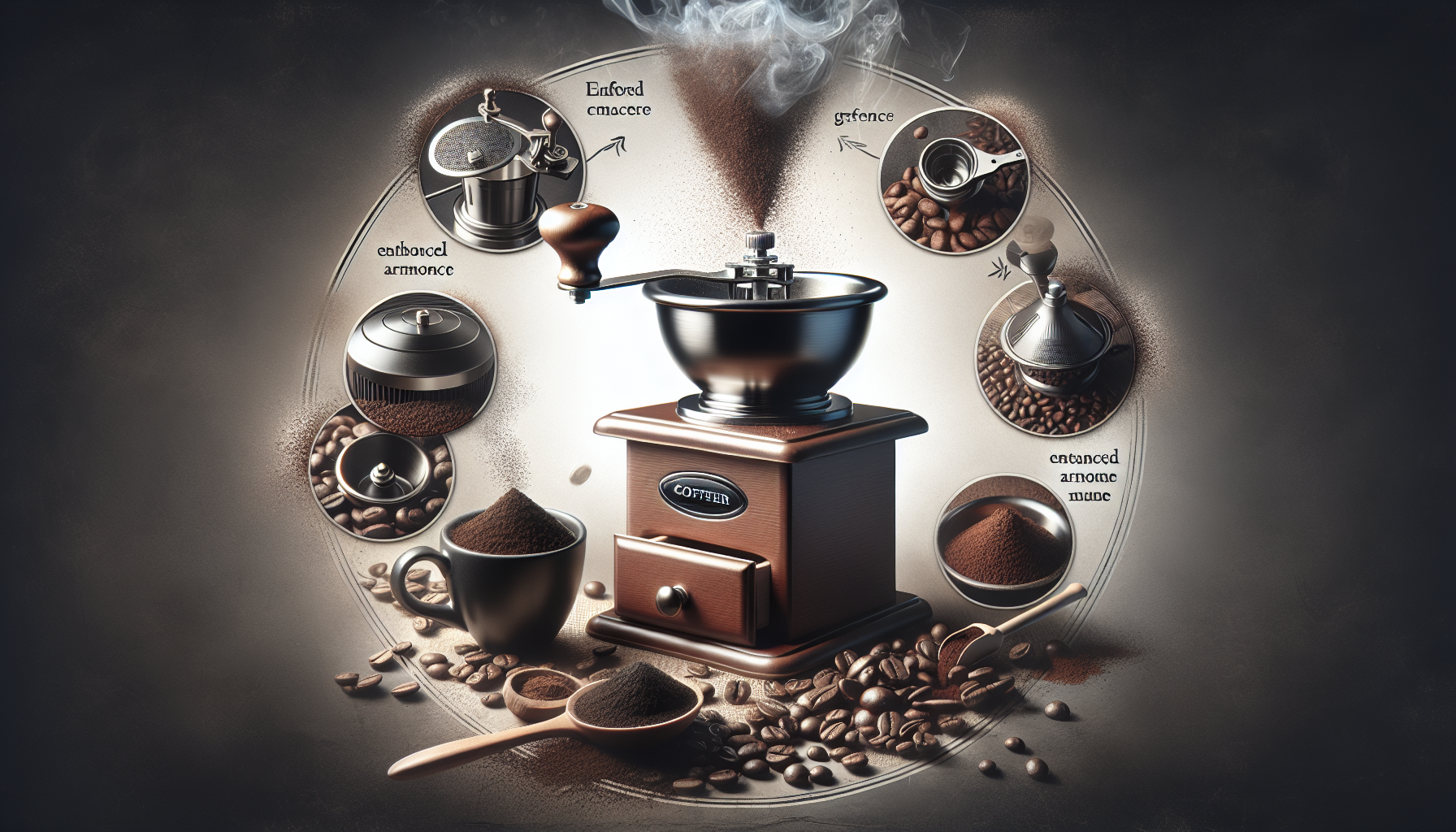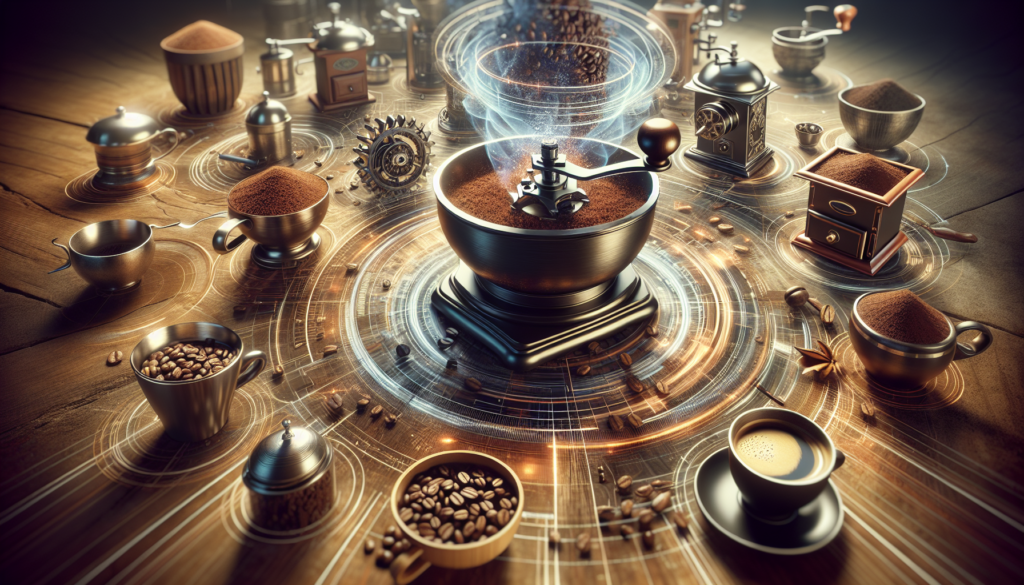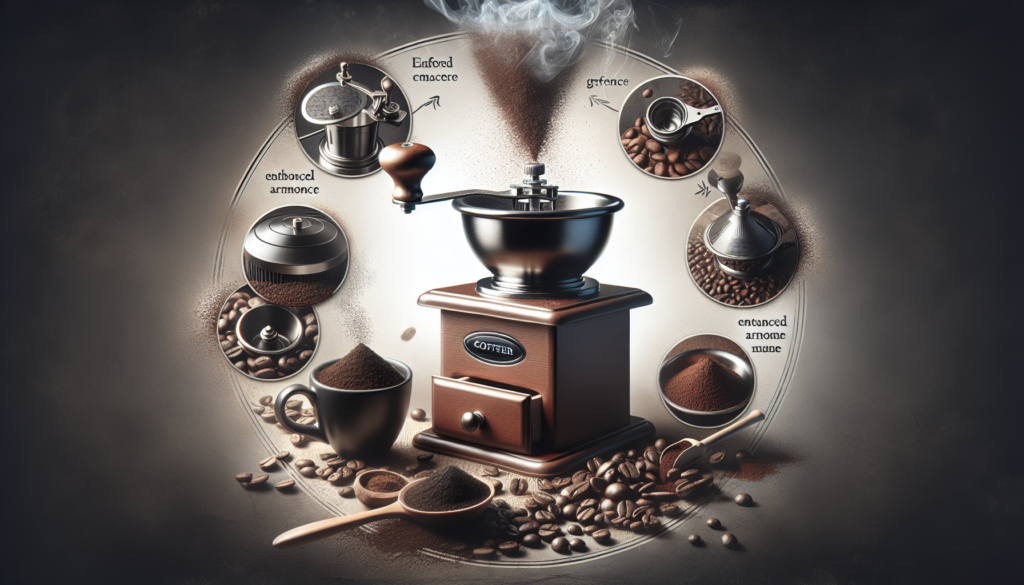
Whether you’re a coffee connoisseur or simply enjoy a morning cup of joe, have you ever wondered about the secret behind the perfect brew? Look no further than the humble coffee grinder. Often overlooked, the coffee grinder plays a crucial role in unlocking the full potential of your coffee beans. In this article, we’ll delve into the intricate relationship between the grinder and your coffee recipes, and discover how it can elevate your coffee experience to new heights. Get ready to unravel the secrets of crafting the perfect cup!

The Importance of the Coffee Grinder
When it comes to brewing a perfect cup of coffee, there are multiple factors that contribute to its quality and taste. One such factor that often gets overlooked is the coffee grinder. Many people tend to focus on the importance of quality beans and brewing methods, but the grinder plays a crucial role in the coffee-making process. So why is the coffee grinder so important? Let’s dive in and explore its significance.
Grinding Consistency
Consistency is key when it comes to grinding coffee beans. The size of the ground coffee particles directly affects the extraction process and ultimately the flavor of your brew. A good coffee grinder ensures that the particles are evenly sized, allowing for a more balanced and consistent extraction. On the other hand, an inconsistent grind can lead to over-extraction or under-extraction, resulting in an imbalanced cup of coffee. Therefore, investing in a high-quality grinder will significantly improve the consistency of your coffee grounds.
Flavor Extraction
The extraction of flavor compounds from coffee beans relies on surface area exposure. When the beans are ground, their surface area increases, making it easier for water to interact with the coffee particles and extract flavor. A good grinder helps to achieve an optimal extraction by producing uniform grind sizes, which allows for even extraction of flavors. This ensures a well-rounded and flavorful cup of coffee, with all the delightful notes and nuances present in every sip.
Achieving Desired Strength
Different coffee brewers have varying preferences when it comes to the strength of their coffee. Whether you prefer a bold and strong cup or a milder and smoother brew, the grind size plays a significant role in achieving your desired strength. A finer grind size increases the surface area of the coffee particles, resulting in a stronger cup, while a coarser grind size produces a milder brew. The coffee grinder allows you to adjust the grind size according to your personal taste and brewing method, giving you full control over the strength of your coffee.
Types of Coffee Grinders
Now that we understand the importance of a coffee grinder, let’s explore the different types available in the market. Each type of grinder has its own unique features, advantages, and disadvantages. Let’s take a look at them:
Blade Grinders
Blade grinders are commonly found in many households due to their affordability and accessibility. These grinders use spinning blades to chop up the coffee beans into smaller particles. While they are budget-friendly, they tend to produce inconsistent grind sizes due to their chopping motion. Additionally, the heat generated by the blades can potentially alter the flavor of the coffee. Therefore, if you are looking for precision and consistency, blade grinders may not be the best option for you.
Burr Grinders
Burr grinders are often considered the gold standard when it comes to grinding coffee beans. They use two burrs, either conical or flat, to crush the beans into consistent particle sizes. The main advantage of burr grinders is their ability to produce uniform grounds, resulting in a more balanced extraction. They also allow for precise control over grind size adjustments. However, burr grinders are usually more expensive than blade grinders. If you are serious about your coffee and value consistency, a burr grinder is worth the investment.
Manual Grinders
For those who enjoy the process of hand-grinding their coffee, manual grinders are a popular choice. These grinders require physical effort to grind the beans, often using a crank or a manual mechanism. Manual grinders are typically compact, portable, and affordable. They are an excellent option for travelers or coffee enthusiasts who appreciate the ritual of grinding coffee by hand. However, manual grinders may require more time and effort compared to electric grinders, so they might not be ideal for those in a hurry.
Electric Grinders
Electric grinders offer convenience and efficiency, making them a popular choice for many coffee lovers. These grinders are powered by electricity, allowing for quick and effortless grinding. Electric grinders often come with various settings for grind size adjustment, giving you more flexibility in brewing methods. However, they can be more expensive than manual grinders and may produce more heat during the grinding process, potentially affecting the flavor of the coffee.
Understanding Grinding Methods
To fully appreciate the role of a coffee grinder, it’s essential to understand the different grinding methods employed by various grinders. The grinding method used can affect the consistency, extraction, and overall quality of the coffee grounds. Let’s explore the three main grinding methods:
Burr Grinding
Burr grinding, as mentioned earlier, utilizes two burrs to crush the coffee beans into consistent particle sizes. These burrs can be made of either stainless steel or ceramic, each offering its own advantages. Burr grinders provide precise control over grind size, allowing you to adjust according to your brewing method. The grinding process is slow and consistent, resulting in evenly ground coffee particles. This method is preferred by coffee enthusiasts who value consistency and quality.
Blade Grinding
Blade grinders, on the other hand, use spinning blades to chop the coffee beans into smaller particles. This method is quick and affordable, but it often produces inconsistent grind sizes. The chopping motion of the blades can result in a mix of fine and coarse particles, leading to uneven extraction. Additionally, the heat generated during the grinding process can affect the flavor of the coffee. Blade grinders are suitable for those who prioritize affordability and are less concerned about precision and consistency.
Manual Grinding
Manual grinding involves using physical effort to grind coffee beans. This method is often associated with manual grinders, as discussed earlier. It allows for a more hands-on approach, where you have complete control over the grinding process. Manual grinding requires patience and effort, but it can be a rewarding experience for those who enjoy the process. The consistency of the grind largely depends on your hand movements, so it may be challenging to achieve uniform results consistently. However, manual grinding is favored by those who appreciate the art and craftsmanship of coffee brewing.

Choosing the Right Grinder for Your Needs
When selecting a coffee grinder, it’s important to consider your specific needs and preferences. Here are a few factors to keep in mind:
Consideration of Budget
Your budget will naturally play a significant role in the type of grinder you choose. Blade grinders tend to be the most affordable, followed by manual grinders, while burr grinders often come at a higher price point. It’s essential to find a balance between your budget constraints and the desired quality of your coffee.
Frequency of Use
If you are an occasional coffee drinker, a less expensive grinder might suffice. However, if you are a daily coffee enthusiast, investing in a higher-quality grinder would be a wise decision. The frequency of use will determine the durability and performance requirements of the grinder.
Grinding Capacity
Consider how much coffee you typically brew in one sitting. If you only make single servings, a smaller grinder might be sufficient. However, if you often brew for a larger group or prefer to grind a larger batch at once, opt for a grinder with a higher grinding capacity.
Convenience
Think about your lifestyle and how much time and effort you are willing to invest in grinding coffee. Electric grinders offer convenience and speed, while manual grinders require more physical effort but provide a more immersive experience. Consider your priorities and choose a grinder that aligns with your preferences.
Grind Size and Its Impact on Coffee
The size of the coffee grounds has a significant impact on the overall brewing process and the final flavor of your cup. Here are some key points to understand about grind size:
Different Grind Sizes
There are various grind sizes that you can choose from, ranging from extra fine to extra coarse. Each grind size is suitable for different brewing methods. For example, espresso requires a fine grind, while French press calls for a more coarse grind. Experimenting with different grind sizes will help you discover the perfect balance for each brewing method.
Effects on Extraction Time
The extraction time refers to the duration it takes for water to extract flavor from the coffee grounds. Larger grinds take longer to extract, while smaller grinds extract more quickly. Finding the right balance is crucial for achieving the desired flavor and strength in your coffee.
Flavor Profiles
Different grind sizes can enhance or diminish certain flavor profiles in your coffee. Finer grinds tend to result in more pronounced flavors, while coarser grinds often bring out subtle and delicate notes. Understanding the impact of grind size on flavor profiles will help you tailor your brewing process to achieve the ideal taste.
Adjusting Grind Size for Different Brewing Methods
To achieve the best results with your chosen brewing method, it’s important to adjust the grind size accordingly. Here are some general guidelines for common brewing methods:
Pour Over
For pour-over coffee brewing, a medium-fine grind is typically recommended. This grind size allows for a balanced extraction and helps to control the flow rate of water through the coffee grounds. Experiment with your pour-over technique and adjust the grind size to find your preferred taste.
French Press
French press brewing requires a coarse grind to prevent the coffee grounds from passing through the mesh filter. A consistent and coarse grind size ensures a full-bodied and flavorful cup of coffee. Avoid using fine grinds in a French press, as they may result in unwanted sediments in your brew.
Espresso
Espresso brewing demands a fine grind size to facilitate the optimum extraction process. The high pressure and short extraction time of espresso machines require finer particles to achieve the desired flavor concentration. It’s crucial to invest in a good quality burr grinder capable of producing consistently fine grounds.
Cold Brew
Cold brew coffee requires a coarse grind size, similar to French press brewing. The prolonged steeping time and low water-to-coffee ratio in cold brewing make a coarse grind ideal. This allows for a smoother extraction, resulting in a refreshing and less acidic cold brew.
Tips for Grinding Coffee
To make the most out of your coffee grinder, here are some handy tips to elevate your grinding experience:
Calibrating Your Grinder
Periodically calibrate your grinder to ensure consistency in the grind size. This involves adjusting the settings and making small test grinds to ensure that the desired result is achieved. Calibration helps correct any inconsistencies that may arise over time.
Keeping Your Grinder Clean
Regularly cleaning your grinder is essential for maintaining its performance and preventing any buildup of coffee oils and residue. Follow the manufacturer’s instructions for cleaning and remember to disassemble, clean, and reassemble the grinder components carefully.
Proper Storage of Coffee Beans
To preserve the freshness of your coffee beans, store them in an airtight container placed in a cool and dark location. Avoid exposing the beans to light, air, or moisture, as these elements can compromise the quality and flavor of your coffee.
Avoiding Heat Build-up
Heat generated during the grinding process can affect the flavor of your coffee. To minimize heat build-up, avoid grinding large batches at once, as it can lead to overheating. Instead, opt for smaller grinding cycles with breaks in between to allow the grinder to cool down.
Understanding the Role of Freshly Ground Coffee
Finally, let’s delve into the importance of using freshly ground coffee:
Oxidation and Flavor Loss
Once coffee beans are ground, they begin to oxidize, leading to a loss of flavor and aroma over time. The process of oxidation is accelerated when the surface area of the coffee increases, making freshly ground coffee essential for a vibrant and flavorful brew.
Retaining Aromas
The aromas present in coffee are delicate and volatile, susceptible to evaporation and degradation. By grinding coffee beans just before brewing, you can capture and preserve the aromatic compounds for a more aromatic and enjoyable cup of coffee.
Enhancing Coffee Brewing
Freshly ground coffee allows for a more efficient and effective extraction process. The increased surface area of the coffee particles maximizes the interaction with water, resulting in a more complete extraction of flavors. This, in turn, enhances the overall quality and taste of your coffee.
Troubleshooting Common Grinding Issues
Despite the best efforts, coffee grinding can sometimes present challenges. Here are a few common issues and how to troubleshoot them:
Uneven Grinds
Inconsistent grind sizes can lead to imbalanced extraction and a subpar cup of coffee. To address this issue, consider investing in a high-quality burr grinder, as it is known for producing consistent and uniform grounds. If using a blade grinder, try shaking it gently while grinding to ensure a more even result.
Inconsistent Extraction
If you find that your coffee brews are often inconsistent in flavor and strength, the culprit may be uneven extraction. In addition to ensuring a consistent grind size, make sure to use a proper brewing technique, including accurate water temperature, correct brewing time, and thorough saturation of coffee grounds.
Over-Extraction or Under-Extraction
Over-extraction occurs when the coffee grounds are exposed to water for too long or when the grind size is too fine. This can result in a bitter and overbearing taste. Conversely, under-extraction happens when the coffee is not given enough time to brew or when the grind size is too coarse. This often leads to a weak and bland cup of coffee. Adjusting the grind size and brewing time can help achieve the ideal extraction.
Grinder Calibration Problems
Over time, the settings of your grinder may change, leading to inconsistencies in grind size. If you notice a significant deviation from your desired results, consider recalibrating your grinder. Refer to the manufacturer’s instructions for guidance or seek professional assistance if needed.
Conclusion
The coffee grinder is an indispensable tool in the pursuit of the perfect cup of coffee. Its role in achieving consistency, controlling flavor extraction, and adjusting strength cannot be overstated. Whether you choose a blade grinder, burr grinder, manual grinder, or electric grinder, understanding the grinding methods and choosing the right grinder for your needs will greatly enhance your coffee brewing experience. Remember to pay attention to grind size, experiment with different brewing methods, and savor the freshness and aromas of freshly ground coffee. With these insights and tips, you’ll be well on your way to crafting your own perfect cup of coffee.